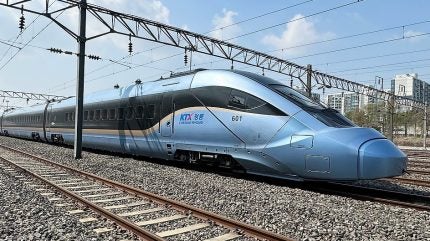
Korail’s new high-speed Hyundai Rotem train has entered limited service in May. The KTX-Cheong-Ryong, formerly known as EMU-320 or Korail Class 160000, is based on the design of the KTX-Eum. It has undergone several redesigns since the project’s inception in 2016.
The trainsets will consist of eight cars, with driving cars at each end and powered-intermediate passenger cars in between. The nearly 200m-long trains are capable of 320km/h in service and will carry nearly 550 passengers at peak times.
Two Cheong-Ryong’s are currently in service on the Gyeongbu line from Seoul to Busn, and the Honam line, which splits from the Seoul-Busan direction to connect to Mokpo. These services currently operate twice daily on weekdays and four times each day on weekends. A further 17 units are expected to enter service by 2027.
While the external design is similar to the existing high-speed trains on South Korea’s network, the Hyudai code gives an indication to the work the manufacturer has done internally. EMU-320 refers to its maximum operating speed, 80km/h more than older EMU-260 rolling stock.
The power supply will be provided by overhead catenary lines and a pantograph, powered at 25kV.
Korail and high-speed operator SR Corporation said the interiors of the new train will offer a much improved journey experience for customers.
How well do you really know your competitors?
Access the most comprehensive Company Profiles on the market, powered by GlobalData. Save hours of research. Gain competitive edge.

Thank you!
Your download email will arrive shortly
Not ready to buy yet? Download a free sample
We are confident about the unique quality of our Company Profiles. However, we want you to make the most beneficial decision for your business, so we offer a free sample that you can download by submitting the below form
By GlobalDataThe first upgrade is to the seats, which will be switched to face the direction of travel by the driver before passengers arrive. They will also align with windows, an area Korail has worked on specifically with designers on several previous models of high-speed trains.
But the improvements aren’t limited to seat location and layout, they will also boast “airline-style” entertainment seat-back systems. According to Korean media ChosunBiz, passengers can watch programmes on Korail’s internal system, access YouTube, or connect personal devices via wireless internet. Sockets, USB ports and wireless charging facilities are also provided for each passenger.
The trains were first ordered in 2016, but “serious noise concerns” were revealed in 2021, forcing the postponement of delivery. According to reports at the time, noise levels in the drivers’ cab could have exceeded the safe levels of 80dB – above which exposure can cause hearing impairment. Along with fixing the problem, Hyundai Rotem paid a fine of $13.9m for the significant delays.






